- Docs Home
- About TiDB
- Quick Start
- Develop
- Overview
- Quick Start
- Build a TiDB Cluster in TiDB Cloud (Developer Tier)
- CRUD SQL in TiDB
- Build a Simple CRUD App with TiDB
- Example Applications
- Connect to TiDB
- Design Database Schema
- Write Data
- Read Data
- Transaction
- Optimize
- Troubleshoot
- Reference
- Cloud Native Development Environment
- Third-party Support
- Deploy
- Software and Hardware Requirements
- Environment Configuration Checklist
- Plan Cluster Topology
- Install and Start
- Verify Cluster Status
- Test Cluster Performance
- Migrate
- Overview
- Migration Tools
- Migration Scenarios
- Migrate from Aurora
- Migrate MySQL of Small Datasets
- Migrate MySQL of Large Datasets
- Migrate and Merge MySQL Shards of Small Datasets
- Migrate and Merge MySQL Shards of Large Datasets
- Migrate from CSV Files
- Migrate from SQL Files
- Migrate from One TiDB Cluster to Another TiDB Cluster
- Migrate from TiDB to MySQL-compatible Databases
- Advanced Migration
- Integrate
- Maintain
- Monitor and Alert
- Troubleshoot
- TiDB Troubleshooting Map
- Identify Slow Queries
- Analyze Slow Queries
- SQL Diagnostics
- Identify Expensive Queries Using Top SQL
- Identify Expensive Queries Using Logs
- Statement Summary Tables
- Troubleshoot Hotspot Issues
- Troubleshoot Increased Read and Write Latency
- Save and Restore the On-Site Information of a Cluster
- Troubleshoot Cluster Setup
- Troubleshoot High Disk I/O Usage
- Troubleshoot Lock Conflicts
- Troubleshoot TiFlash
- Troubleshoot Write Conflicts in Optimistic Transactions
- Troubleshoot Inconsistency Between Data and Indexes
- Performance Tuning
- Tuning Guide
- Configuration Tuning
- System Tuning
- Software Tuning
- SQL Tuning
- Overview
- Understanding the Query Execution Plan
- SQL Optimization Process
- Overview
- Logic Optimization
- Physical Optimization
- Prepare Execution Plan Cache
- Control Execution Plans
- Tutorials
- TiDB Tools
- Overview
- Use Cases
- Download
- TiUP
- Documentation Map
- Overview
- Terminology and Concepts
- Manage TiUP Components
- FAQ
- Troubleshooting Guide
- Command Reference
- Overview
- TiUP Commands
- TiUP Cluster Commands
- Overview
- tiup cluster audit
- tiup cluster check
- tiup cluster clean
- tiup cluster deploy
- tiup cluster destroy
- tiup cluster disable
- tiup cluster display
- tiup cluster edit-config
- tiup cluster enable
- tiup cluster help
- tiup cluster import
- tiup cluster list
- tiup cluster patch
- tiup cluster prune
- tiup cluster reload
- tiup cluster rename
- tiup cluster replay
- tiup cluster restart
- tiup cluster scale-in
- tiup cluster scale-out
- tiup cluster start
- tiup cluster stop
- tiup cluster template
- tiup cluster upgrade
- TiUP DM Commands
- Overview
- tiup dm audit
- tiup dm deploy
- tiup dm destroy
- tiup dm disable
- tiup dm display
- tiup dm edit-config
- tiup dm enable
- tiup dm help
- tiup dm import
- tiup dm list
- tiup dm patch
- tiup dm prune
- tiup dm reload
- tiup dm replay
- tiup dm restart
- tiup dm scale-in
- tiup dm scale-out
- tiup dm start
- tiup dm stop
- tiup dm template
- tiup dm upgrade
- TiDB Cluster Topology Reference
- DM Cluster Topology Reference
- Mirror Reference Guide
- TiUP Components
- PingCAP Clinic Diagnostic Service
- TiDB Operator
- Dumpling
- TiDB Lightning
- TiDB Data Migration
- About TiDB Data Migration
- Architecture
- Quick Start
- Deploy a DM cluster
- Tutorials
- Advanced Tutorials
- Maintain
- Cluster Upgrade
- Tools
- Performance Tuning
- Manage Data Sources
- Manage Tasks
- Export and Import Data Sources and Task Configurations of Clusters
- Handle Alerts
- Daily Check
- Reference
- Architecture
- Command Line
- Configuration Files
- OpenAPI
- Compatibility Catalog
- Secure
- Monitoring and Alerts
- Error Codes
- Glossary
- Example
- Troubleshoot
- Release Notes
- Backup & Restore (BR)
- TiDB Binlog
- TiCDC
- Dumpling
- sync-diff-inspector
- TiSpark
- Reference
- Cluster Architecture
- Key Monitoring Metrics
- Secure
- Privileges
- SQL
- SQL Language Structure and Syntax
- SQL Statements
ADD COLUMNADD INDEXADMINADMIN CANCEL DDLADMIN CHECKSUM TABLEADMIN CHECK [TABLE|INDEX]ADMIN SHOW DDL [JOBS|QUERIES]ADMIN SHOW TELEMETRYALTER DATABASEALTER INDEXALTER INSTANCEALTER PLACEMENT POLICYALTER TABLEALTER TABLE COMPACTALTER USERANALYZE TABLEBACKUPBATCHBEGINCHANGE COLUMNCOMMITCHANGE DRAINERCHANGE PUMPCREATE [GLOBAL|SESSION] BINDINGCREATE DATABASECREATE INDEXCREATE PLACEMENT POLICYCREATE ROLECREATE SEQUENCECREATE TABLE LIKECREATE TABLECREATE USERCREATE VIEWDEALLOCATEDELETEDESCDESCRIBEDODROP [GLOBAL|SESSION] BINDINGDROP COLUMNDROP DATABASEDROP INDEXDROP PLACEMENT POLICYDROP ROLEDROP SEQUENCEDROP STATSDROP TABLEDROP USERDROP VIEWEXECUTEEXPLAIN ANALYZEEXPLAINFLASHBACK TABLEFLUSH PRIVILEGESFLUSH STATUSFLUSH TABLESGRANT <privileges>GRANT <role>INSERTKILL [TIDB]LOAD DATALOAD STATSMODIFY COLUMNPREPARERECOVER TABLERENAME INDEXRENAME TABLEREPLACERESTOREREVOKE <privileges>REVOKE <role>ROLLBACKSELECTSET DEFAULT ROLESET [NAMES|CHARACTER SET]SET PASSWORDSET ROLESET TRANSACTIONSET [GLOBAL|SESSION] <variable>SHOW ANALYZE STATUSSHOW [BACKUPS|RESTORES]SHOW [GLOBAL|SESSION] BINDINGSSHOW BUILTINSSHOW CHARACTER SETSHOW COLLATIONSHOW [FULL] COLUMNS FROMSHOW CONFIGSHOW CREATE PLACEMENT POLICYSHOW CREATE SEQUENCESHOW CREATE TABLESHOW CREATE USERSHOW DATABASESSHOW DRAINER STATUSSHOW ENGINESSHOW ERRORSSHOW [FULL] FIELDS FROMSHOW GRANTSSHOW INDEX [FROM|IN]SHOW INDEXES [FROM|IN]SHOW KEYS [FROM|IN]SHOW MASTER STATUSSHOW PLACEMENTSHOW PLACEMENT FORSHOW PLACEMENT LABELSSHOW PLUGINSSHOW PRIVILEGESSHOW [FULL] PROCESSSLISTSHOW PROFILESSHOW PUMP STATUSSHOW SCHEMASSHOW STATS_HEALTHYSHOW STATS_HISTOGRAMSSHOW STATS_METASHOW STATUSSHOW TABLE NEXT_ROW_IDSHOW TABLE REGIONSSHOW TABLE STATUSSHOW [FULL] TABLESSHOW [GLOBAL|SESSION] VARIABLESSHOW WARNINGSSHUTDOWNSPLIT REGIONSTART TRANSACTIONTABLETRACETRUNCATEUPDATEUSEWITH
- Data Types
- Functions and Operators
- Overview
- Type Conversion in Expression Evaluation
- Operators
- Control Flow Functions
- String Functions
- Numeric Functions and Operators
- Date and Time Functions
- Bit Functions and Operators
- Cast Functions and Operators
- Encryption and Compression Functions
- Locking Functions
- Information Functions
- JSON Functions
- Aggregate (GROUP BY) Functions
- Window Functions
- Miscellaneous Functions
- Precision Math
- Set Operations
- List of Expressions for Pushdown
- TiDB Specific Functions
- Clustered Indexes
- Constraints
- Generated Columns
- SQL Mode
- Table Attributes
- Transactions
- Garbage Collection (GC)
- Views
- Partitioning
- Temporary Tables
- Cached Tables
- Character Set and Collation
- Placement Rules in SQL
- System Tables
mysql- INFORMATION_SCHEMA
- Overview
ANALYZE_STATUSCLIENT_ERRORS_SUMMARY_BY_HOSTCLIENT_ERRORS_SUMMARY_BY_USERCLIENT_ERRORS_SUMMARY_GLOBALCHARACTER_SETSCLUSTER_CONFIGCLUSTER_HARDWARECLUSTER_INFOCLUSTER_LOADCLUSTER_LOGCLUSTER_SYSTEMINFOCOLLATIONSCOLLATION_CHARACTER_SET_APPLICABILITYCOLUMNSDATA_LOCK_WAITSDDL_JOBSDEADLOCKSENGINESINSPECTION_RESULTINSPECTION_RULESINSPECTION_SUMMARYKEY_COLUMN_USAGEMETRICS_SUMMARYMETRICS_TABLESPARTITIONSPLACEMENT_POLICIESPROCESSLISTREFERENTIAL_CONSTRAINTSSCHEMATASEQUENCESSESSION_VARIABLESSLOW_QUERYSTATISTICSTABLESTABLE_CONSTRAINTSTABLE_STORAGE_STATSTIDB_HOT_REGIONSTIDB_HOT_REGIONS_HISTORYTIDB_INDEXESTIDB_SERVERS_INFOTIDB_TRXTIFLASH_REPLICATIKV_REGION_PEERSTIKV_REGION_STATUSTIKV_STORE_STATUSUSER_PRIVILEGESVIEWS
METRICS_SCHEMA
- UI
- TiDB Dashboard
- Overview
- Maintain
- Access
- Overview Page
- Cluster Info Page
- Top SQL Page
- Key Visualizer Page
- Metrics Relation Graph
- SQL Statements Analysis
- Slow Queries Page
- Cluster Diagnostics
- Search Logs Page
- Instance Profiling
- Session Management and Configuration
- FAQ
- CLI
- Command Line Flags
- Configuration File Parameters
- System Variables
- Storage Engines
- Telemetry
- Errors Codes
- Table Filter
- Schedule Replicas by Topology Labels
- FAQs
- Release Notes
- All Releases
- Release Timeline
- TiDB Versioning
- v6.1
- v6.0
- v5.4
- v5.3
- v5.2
- v5.1
- v5.0
- v4.0
- v3.1
- v3.0
- v2.1
- v2.0
- v1.0
- Glossary
BR Use Cases
Backup & Restore (BR) is a tool for distributed backup and restoration of the TiDB cluster data.
This document describes common backup and restoration scenarios:
- Back up a single table to a network disk (recommended for production environments)
- Restore data from a network disk (recommended for production environments)
- Back up a single table to a local disk
- Restore data from a local disk
This document aims to help you achieve the following goals:
- Back up and restore data using a network disk or local disk correctly.
- Get the status of a backup or restoration operation through monitoring metrics.
- Learn how to tune performance during the backup or restoration operation.
- Troubleshoot the possible anomalies during the backup operation.
Audience
You are expected to have a basic understanding of TiDB and TiKV.
Before reading on, make sure you have read BR Overview, especially Usage Restrictions and Some tips.
Prerequisites
This section introduces the recommended method of deploying TiDB, cluster versions, the hardware information of the TiKV cluster, and the cluster configuration for the use case demonstrations.
You can estimate the performance of your backup or restoration operation based on your own hardware and configuration. It is recommended that you use a network disk to back up and restore data. This spares you from collecting backup files and greatly improves the backup efficiency especially when the TiKV cluster is in a large scale.
Deployment method
It is recommended that you deploy the TiDB cluster using TiUP and install BR using TiUP.
Cluster versions
- TiDB: v6.1.0
- TiKV: v6.1.0
- PD: v6.1.0
- BR: v6.1.0
It is recommended that you use the latest version of TiDB/TiKV/PD/BR and make sure that the BR version is consistent with the TiDB version.
TiKV hardware information
- Operating system: CentOS Linux release 7.6.1810 (Core)
- CPU: 16-Core Common KVM processor
- RAM: 32 GB
- Disk: 500 GB SSD * 2
- NIC: 10 Gigabit network card
Cluster configuration
BR directly sends commands to the TiKV cluster and are not dependent on the TiDB server, so you do not need to configure the TiDB server when using BR.
- TiKV: default configuration
- PD: default configuration
Others
In addition to the preceding prerequisites, you should also perform the following checks before performing the backup and restoration.
Check before backup
Before running the br backup command, make sure the following conditions are met:
- No DDL statements are running on the TiDB cluster.
- The target storage device has required space (no less than 1/3 of the disk space of the backup cluster).
Check before restoration
Before running the br restore command, check the target cluster to ensure that the table in this cluster does not have a duplicate name.
Back up a single table to a network disk (recommended for production environments)
Run the br backup command to back up the single table data --db batchmark --table order_line to the specified path local:///br_data in the network disk.
Backup prerequisites
- Check before backup
- Configure a high-performance SSD hard disk host as the NFS server to store data, and all BR nodes, TiKV nodes, and TiFlash nodes as NFS clients. Mount the same path (for example,
/br_data) to the NFS server for NFS clients to access the server. - The total transfer rate between the NFS server and all NFS clients must reach at least
the number of TiKV instances * 150MB/s. Otherwise, the network I/O might become the performance bottleneck.
- During data backup, because only the data of leader replicas are backed up, even if there is a TiFlash replica in the cluster, BR can complete the backup without mounting TiFlash nodes.
- When restoring data, BR will restore the data of all replicas. Also, TiFlash nodes need access to the backup data for BR to complete the restore. Therefore, before the restore, you must mount TiFlash nodes to the NFS server.
Topology
The following diagram shows the typology of BR:
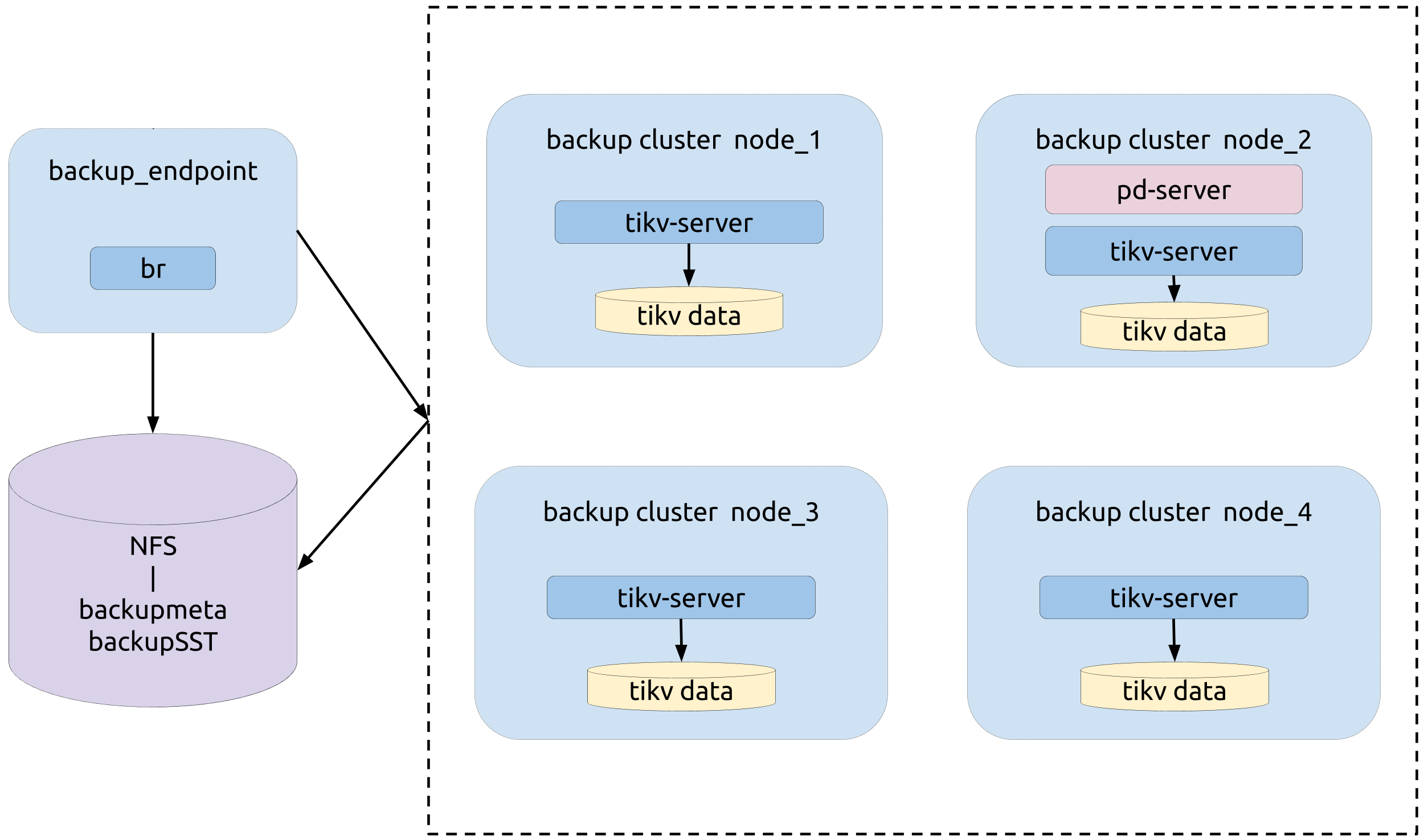
Backup operation
Run the br backup command:
bin/br backup table \
--db batchmark \
--table order_line \
-s local:///br_data \
--pd ${PD_ADDR}:2379 \
--log-file backup-nfs.log
Monitoring metrics for the backup
During the backup process, pay attention to the following metrics on the monitoring panels to get the status of the backup process.
Backup CPU Utilization: the CPU usage rate of each working TiKV node in the backup operation (for example, backup-worker and backup-endpoint).

IO Utilization: the I/O usage rate of each working TiKV node in the backup operation.

BackupSST Generation Throughput: the backupSST generation throughput of each working TiKV node in the backup operation, which is normally around 150 MB/s.
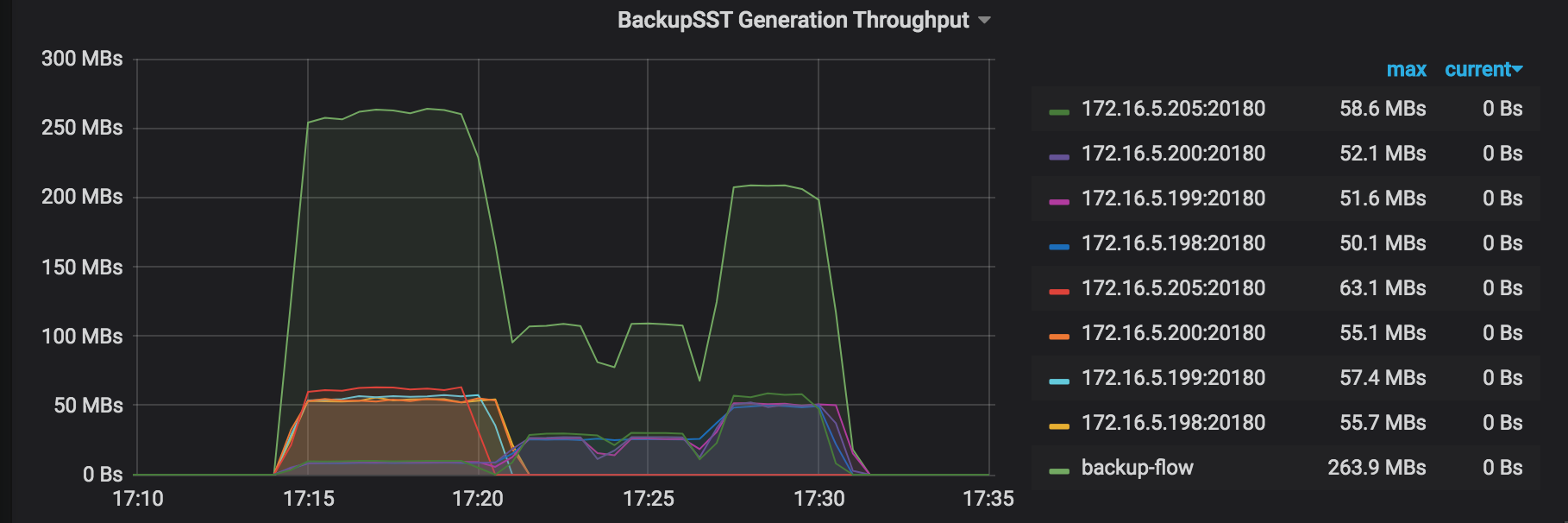
One Backup Range Duration: the duration of backing up a range, which is the total time cost of scanning KVs and storing the range as the backupSST file.
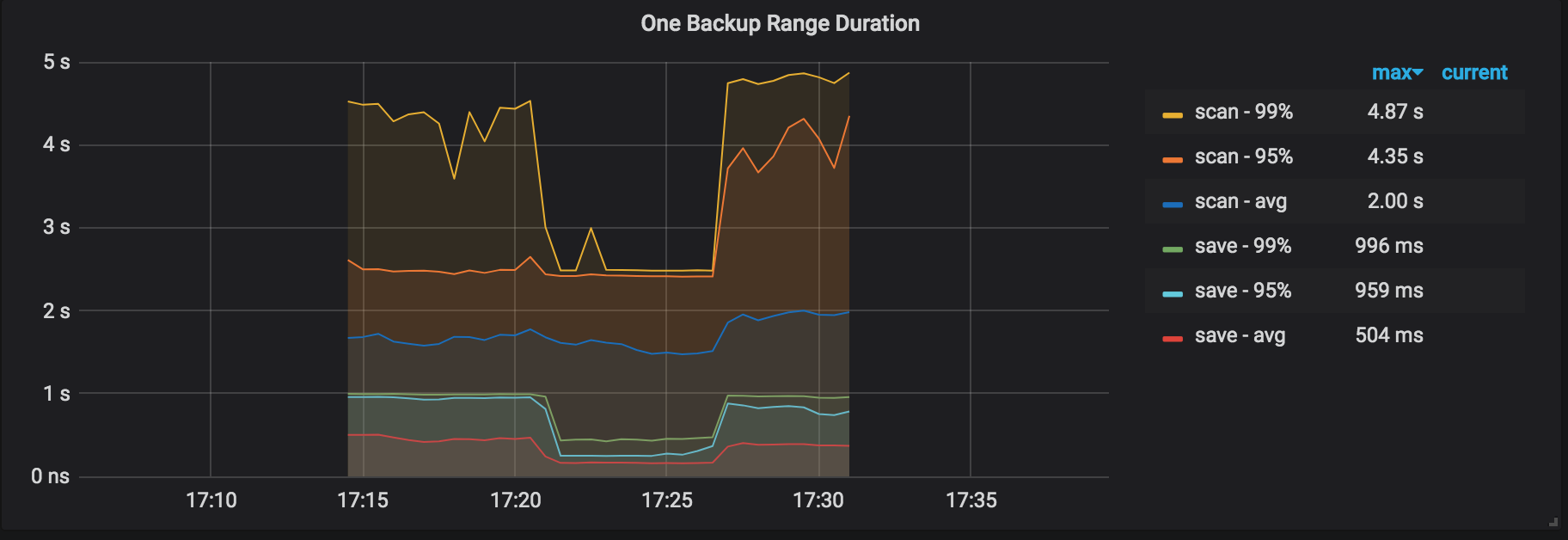
One Backup Subtask Duration: the duration of each sub-task into which a backup task is divided.
- In this task, the single table to be backed up has three indexes and the task is normally divided into four sub-tasks.
- The panel in the following image has 20 points on it, 10 blue and 10 yellow, indicating that there are 10 sub-tasks. Region scheduling might occur during the backup process, so a few retries is normal.

Backup Errors: the errors occurred during the backup process. No error occurs in normal situations. Even if a few errors occur, the backup operation has the retry mechanism which might increase the backup time but does not affect the operation correctness.

Checksum Request Duration: the duration of the admin checksum request in the backup cluster.

Backup results explanation
When finishing the backup, BR outputs the backup summary to the console.
In the log specified before running the backup command, you can get the statistical information of the backup operation from this log. Search "summary" in this log, you can see the following information:
["Full backup Success summary:
total backup ranges: 2,
total success: 2,
total failed: 0,
total take(Full backup time): 31.802912166s,
total take(real time): 49.799662427s,
total size(MB): 5997.49,
avg speed(MB/s): 188.58,
total kv: 120000000"]
["backup checksum"=17.907153678s]
["backup fast checksum"=349.333µs]
["backup total regions"=43]
[BackupTS=422618409346269185]
[Size=826765915]
The preceding log includes the following information:
total take(Full backup time): Backup durationtotal take(real time): Total runtime of the applicationtotal size(MB): The size of the backup dataavg speed(MB/s): Backup throughputtotal kv: The number of backed-up KV pairsbackup checksum: Backup checksum durationbackup fast checksum: The total duration of calculating the checksum, KV pairs, and bytes of each tablebackup total regions: The total number of backup RegionsBackupTS: The snapshot timestamp of the backup dataSize: The actual size of the backup data in the disk after compression
From the preceding information, the throughput of a single TiKV instance can be calculated: avg speed(MB/s)/tikv_count = 62.86.
Performance tuning
If the resource usage of TiKV does not become an obvious bottleneck during the backup process (for example, in the Monitoring metrics for the backup, the highest CPU usage rate of backup-worker is around 1500% and the overall I/O usage rate is below 30%), you can try to increase the value of --concurrency (4 by default) to tune the performance. But this performance tuning method is not suitable for the use cases of many small tables. See the following example:
bin/br backup table \
--db batchmark \
--table order_line \
-s local:///br_data/ \
--pd ${PD_ADDR}:2379 \
--log-file backup-nfs.log \
--concurrency 16

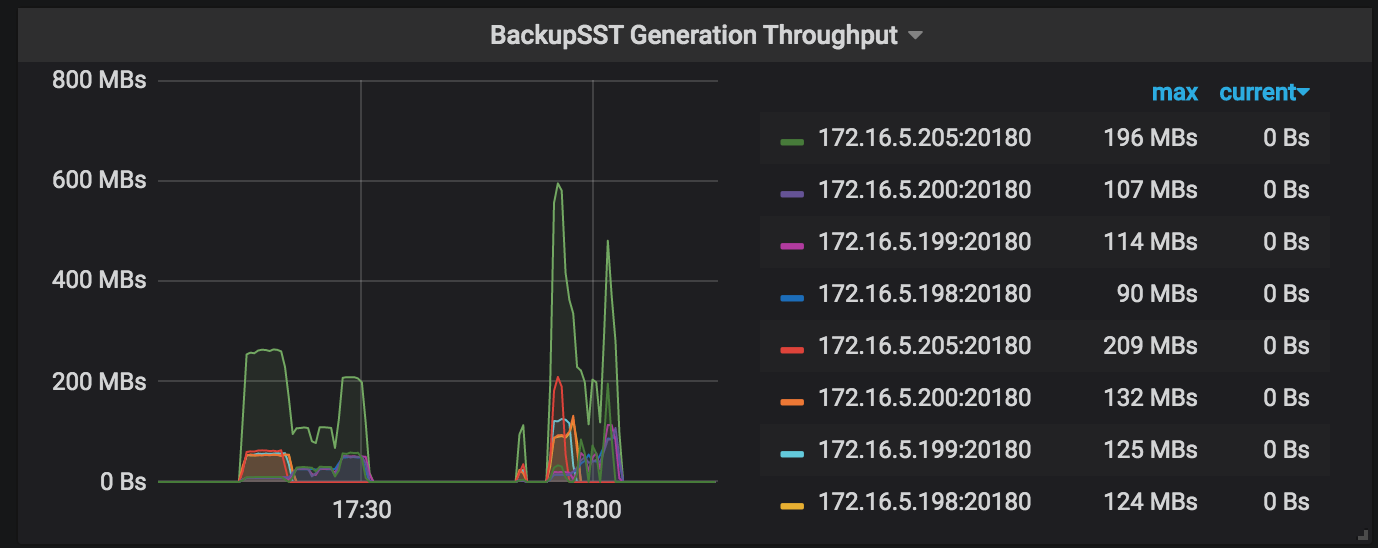
The tuned performance results are as follows (with the same data size):
- Backup duration (
total take(s)): reduced from986.43to535.53 - Backup throughput (
avg speed(MB/s)): increased from358.09to659.59 - Throughput of a single TiKV instance (
avg speed(MB/s)/tikv_count): increased from89to164.89
Restore data from a network disk (recommended for production environments)
Use the br restore command to restore the complete backup data to an offline cluster. Currently, BR does not support restoring data to an online cluster.
Restoration prerequisites
Topology
The following diagram shows the typology of BR:
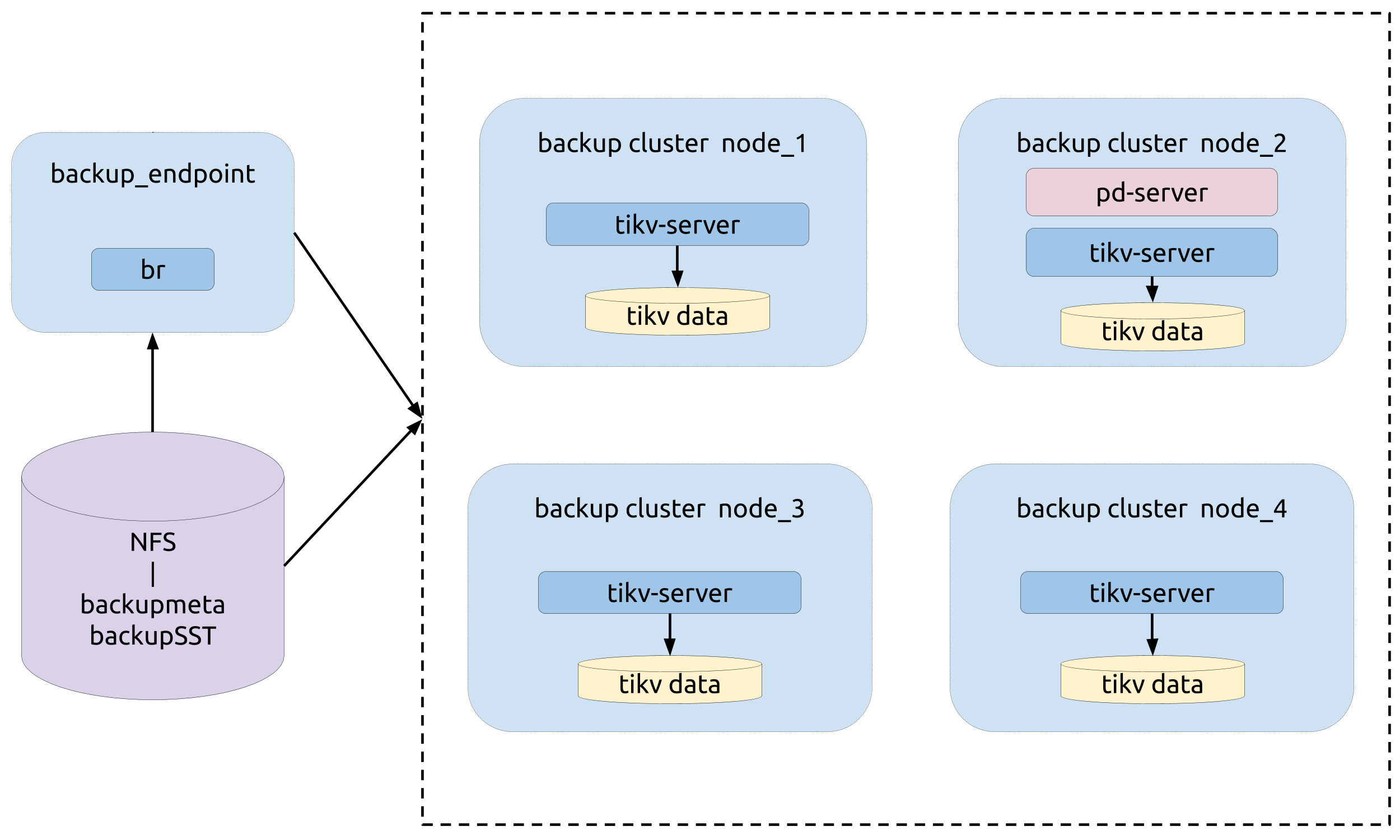
Restoration operation
Run the br restore command:
bin/br restore table --db batchmark --table order_line -s local:///br_data --pd 172.16.5.198:2379 --log-file restore-nfs.log
Monitoring metrics for the restoration
During the restoration process, pay attention to the following metrics on the monitoring panels to get the status of the restoration process.
CPU: the CPU usage rate of each working TiKV node in the restoration operation.
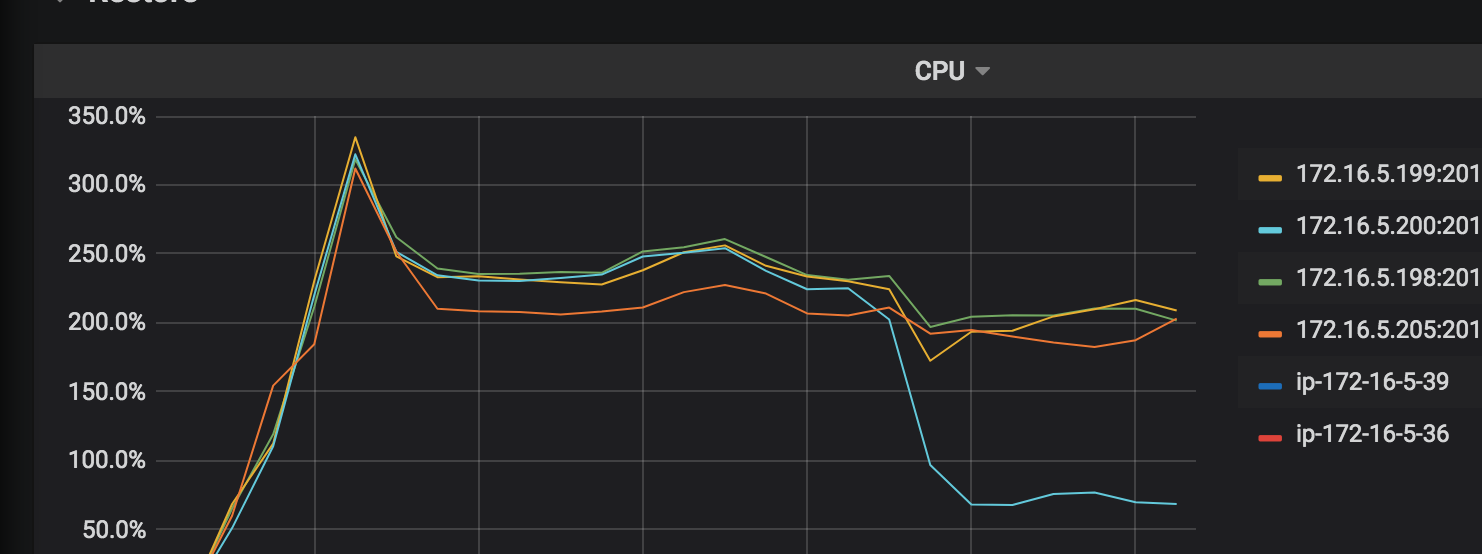
IO Utilization: the I/O usage rate of each working TiKV node in the restoration operation.
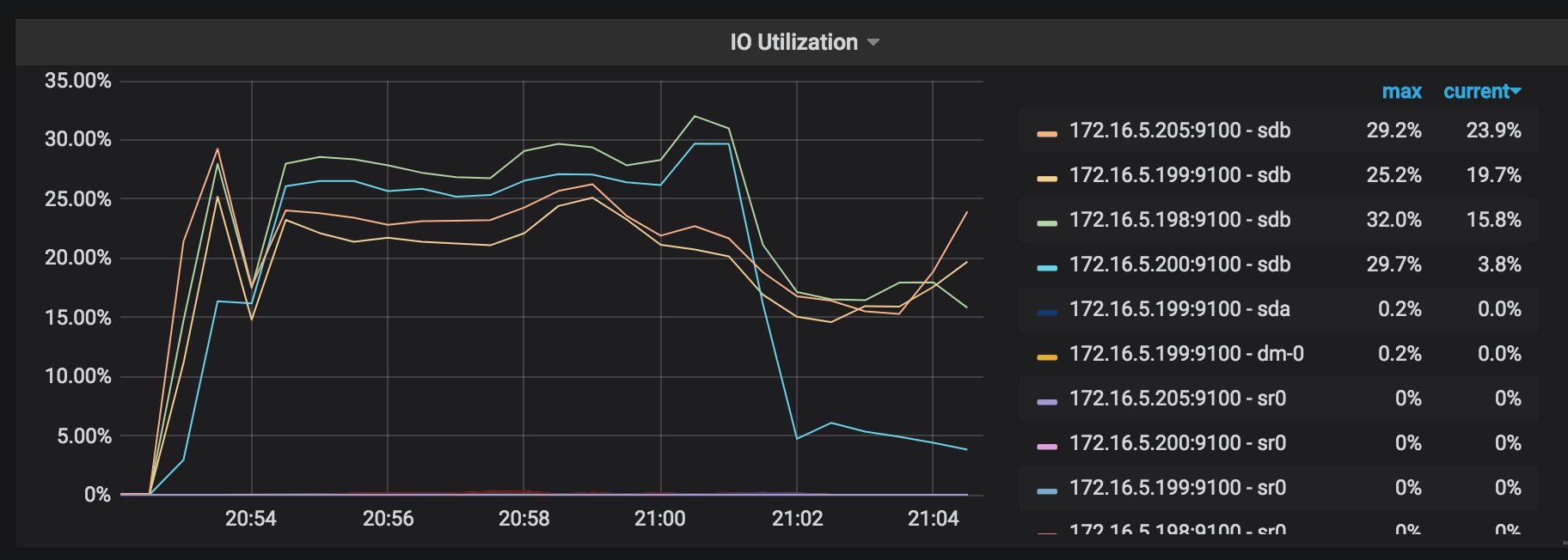
Region: the Region distribution. The more even Regions are distributed, the better the restoration resources are used.
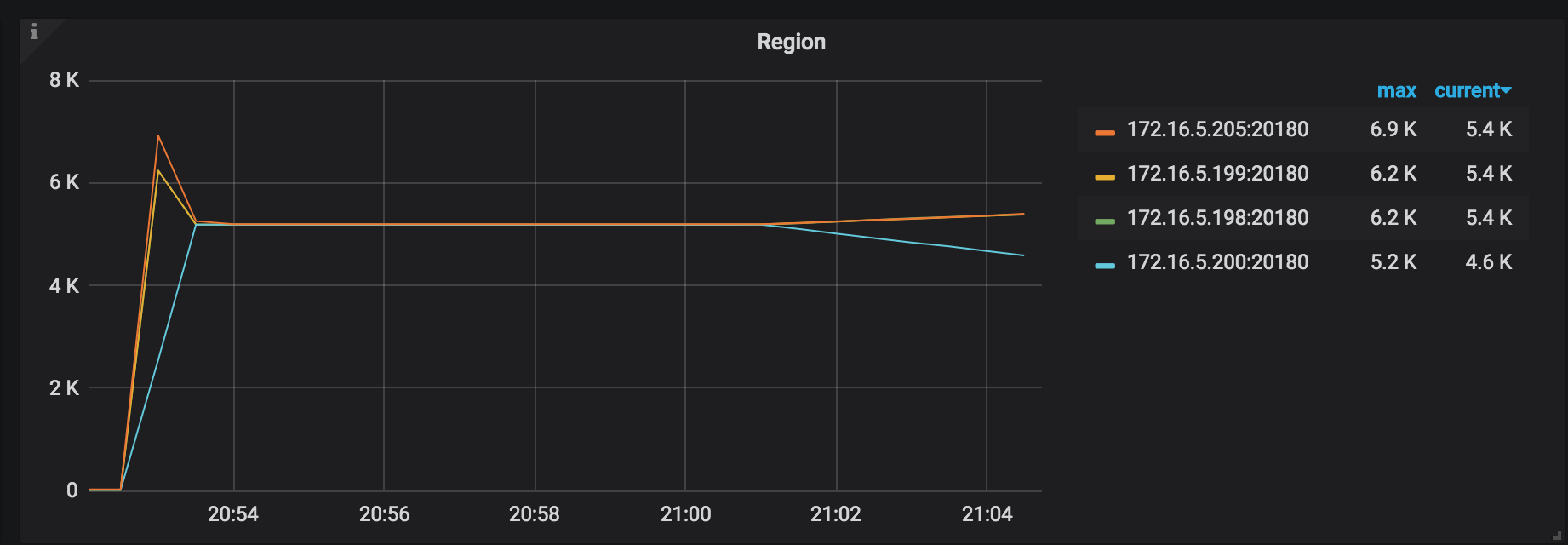
Process SST Duration: the delay of processing the SST files. When restoring a table, if tableID is changed, you need to rewrite tableID. Otherwise, tableID is renamed. Generally, the delay of rewriting is longer than that of renaming.
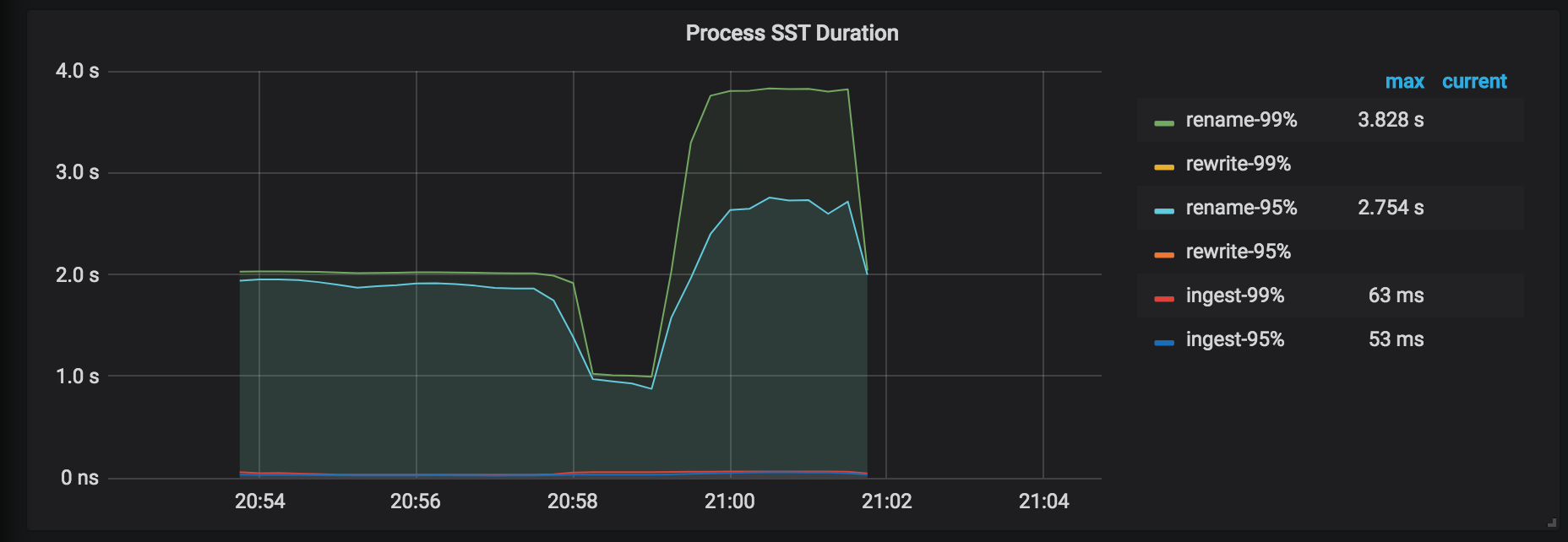
DownLoad SST Throughput: the throughput of downloading SST files from External Storage.

Restore Errors: the errors occurred during the restoration process.
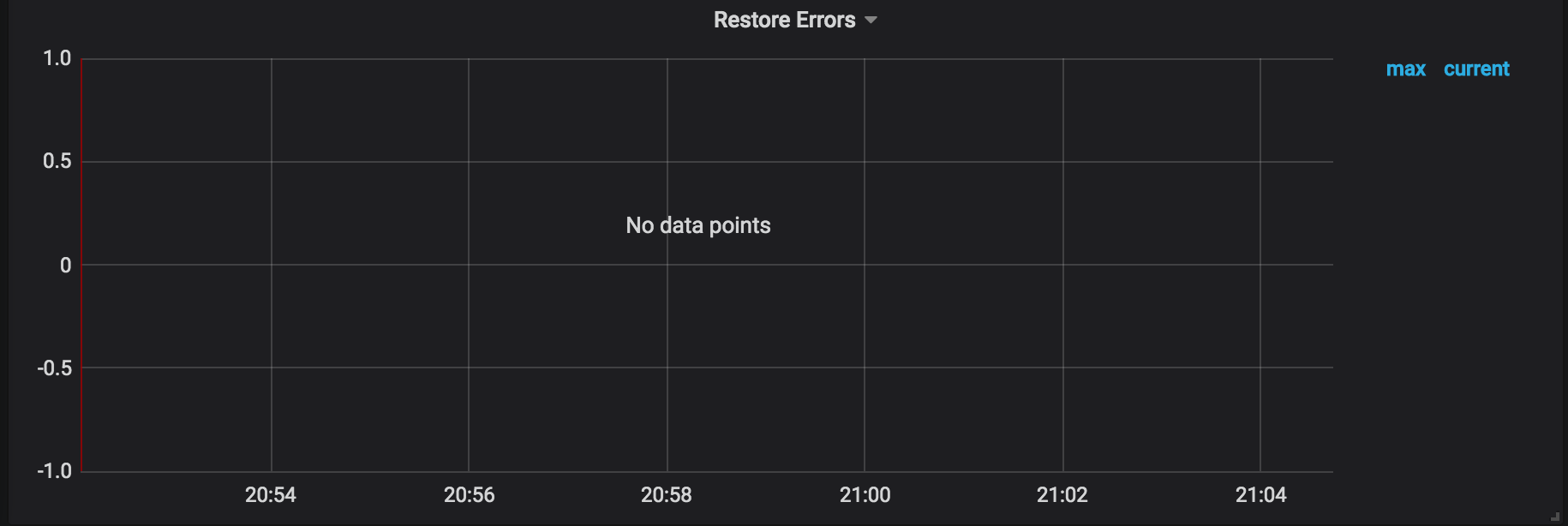
Checksum Request Duration: the duration of the admin checksum request. This duration for the restoration is longer than that for the backup.
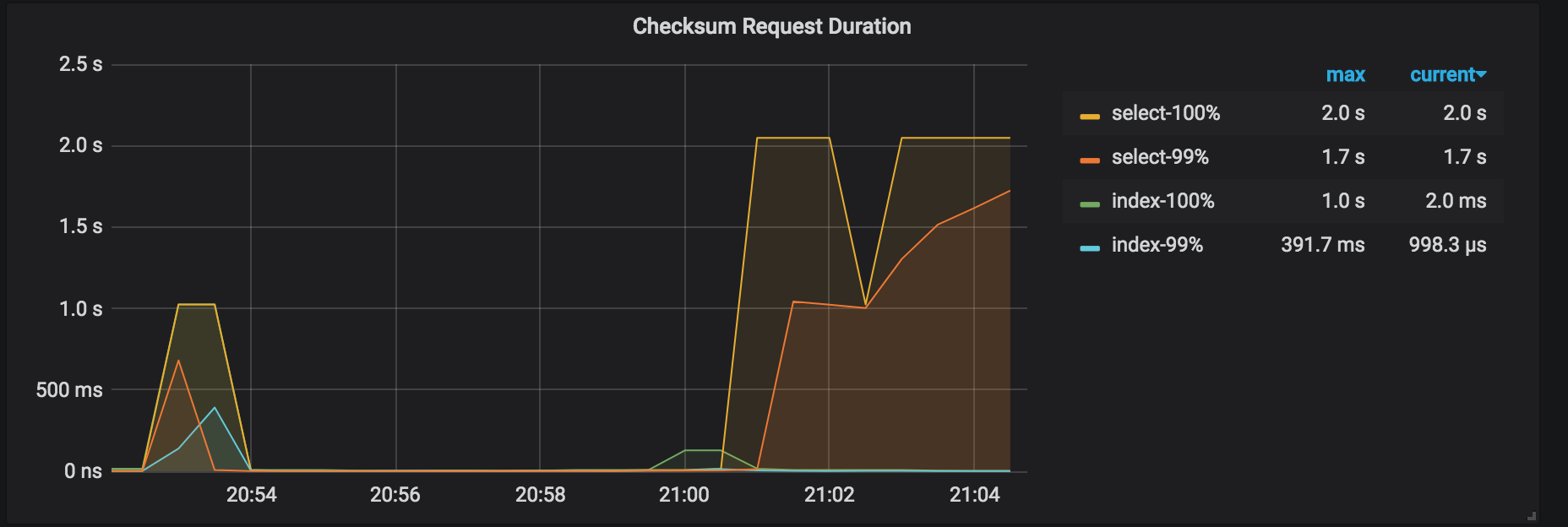
Restoration results explanation
In the log specified before running the restoration command, you can get the statistical information of the restoration operation from this log. Search "summary" in this log, you can see the following information:
["Table Restore summary:
total restore tables: 1,
total success: 1,
total failed: 0,
total take(Full restore time): 17m1.001611365s,
total take(real time): 16m1.371611365s,
total kv: 5659888624,
total size(MB): 353227.18,
avg speed(MB/s): 367.42"]
["restore files"=9263]
["restore ranges"=6888]
["split region"=49.049182743s]
["restore checksum"=6m34.879439498s]
[Size=48693068713]
The preceding log includes the following information:
total take(Full restore time): The restoration durationtotal take(real time): The total runtime of the applicationtotal size(MB): The size of the data to be restoredtotal kv: The number of restored KV pairsavg speed(MB/s): The restoration throughputsplit region: The Region split durationrestore checksum: The restoration checksum durationSize: The actual size of the restored data in the disk
From the preceding information, the following items can be calculated:
- The throughput of a single TiKV instance:
avg speed(MB/s)/tikv_count=91.8 - The average restore speed of a single TiKV instance:
total size(MB)/(split time+restore time)/tikv_count=87.4
Performance tuning
If the resource usage of TiKV does not become an obvious bottleneck during the restore process, you can increase the value of --concurrency (defaults to 128). See the following example:
bin/br restore table --db batchmark --table order_line -s local:///br_data/ --pd 172.16.5.198:2379 --log-file restore-concurrency.log --concurrency 1024
The tuned performance results are as follows (with the same data size):
- Restoration duration (
total take(s)): reduced from961.37to443.49 - Restoration throughput (
avg speed(MB/s)): increased from367.42to796.47 - Throughput of a single TiKV instance (
avg speed(MB/s)/tikv_count): increased from91.8to199.1 - Average restore speed of a single TiKV instance (
total size(MB)/(split time+restore time)/tikv_count): increased from87.4to162.3
Back up a single table to a local disk (recommended for testing environments)
Run the br backup command to back up a single table --db batchmark --table order_line to the specified path local:///home/tidb/backup_local in the local disk.
Backup prerequisites
- Check before backup
- Each TiKV node has a separate disk to store backupSST files.
- The
backup_endpointnode has a separate disk to storebackupmetafiles. - TiKV and the
backup_endpointnode share the same directory (for example,/home/tidb/backup_local) for backup.
Topology
The following diagram shows the typology of BR:
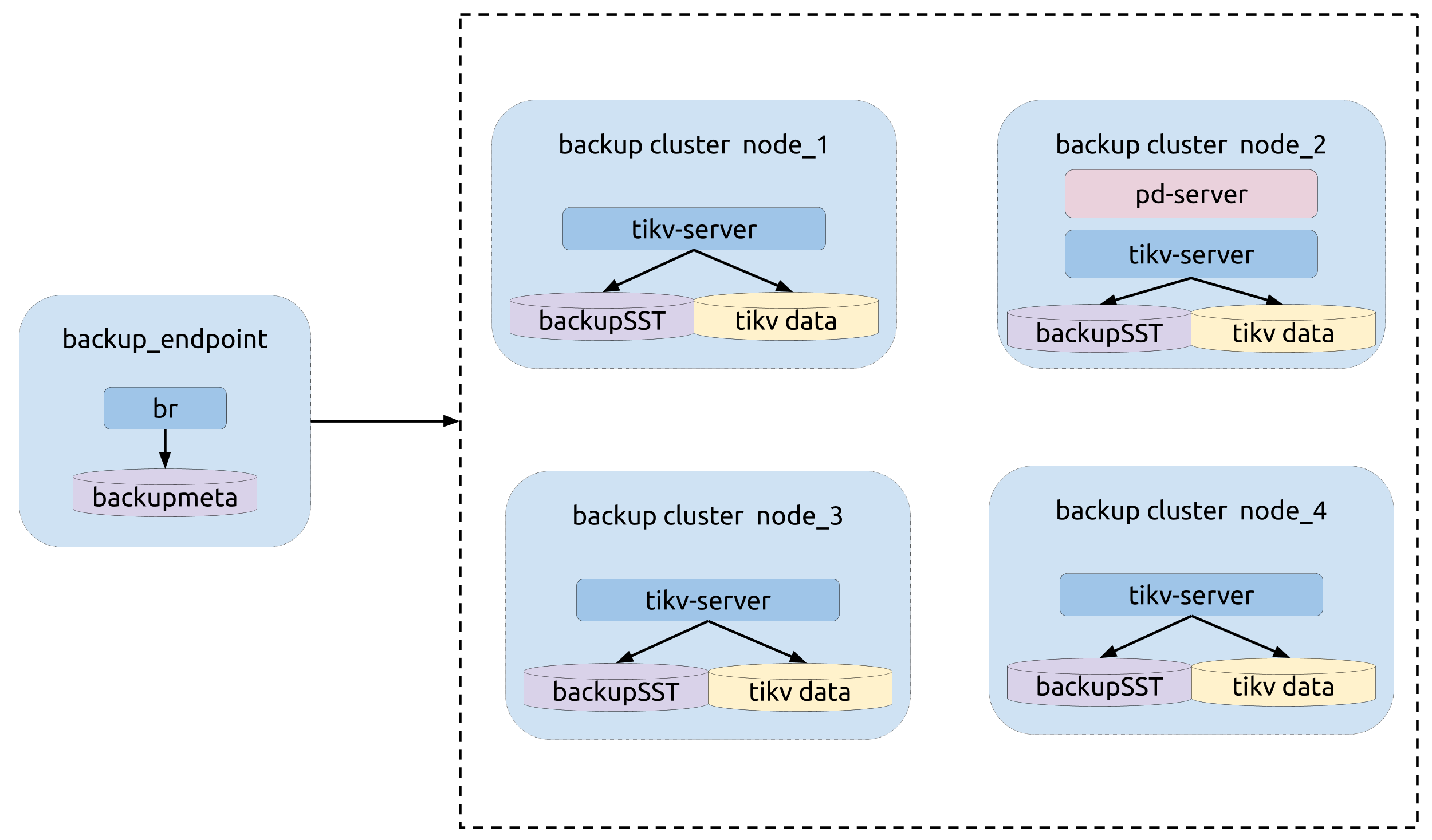
Backup operation
Run the br backup command:
bin/br backup table \
--db batchmark \
--table order_line \
-s local:///home/tidb/backup_local/ \
--pd ${PD_ADDR}:2379 \
--log-file backup_local.log
During the backup process, pay attention to the metrics on the monitoring panels to get the status of the backup process. See Monitoring metrics for the backup for details.
Backup results explanation
In the log specified before running the backup command, you can get the statistical information of the restoration operation from this log. Search "summary" in this log, you can see the following information:
["Table backup summary:
total backup ranges: 4,
total success: 4,
total failed: 0,
total take(s): 551.31,
total kv: 5659888624,
total size(MB): 353227.18,
avg speed(MB/s): 640.71"]
["backup total regions"=6795]
["backup checksum"=6m33.962719217s]
["backup fast checksum"=22.995552ms]
The preceding log includes the following information:
total take(s): The backup durationtotal size(MB): The data sizeavg speed(MB/s): The backup throughputbackup checksum: The backup checksum duration
From the preceding information, the throughput of a single TiKV instance can be calculated: avg speed(MB/s)/tikv_count = 160.
Restore data from a local disk (recommended for testing environments)
Run the br restore command to restore the complete backup data to an offline cluster. Currently, BR does not support restoring data to an online cluster.
Restoration prerequisites
- Check before restore
- The TiKV cluster and the backup data do not have a duplicate database or table. Currently, BR does not support table route.
- Each TiKV node has a separate disk to store backupSST files.
- The
restore_endpointnode has a separate disk to storebackupmetafiles. - TiKV and the
restore_endpointnode share the same directory (for example,/home/tidb/backup_local/) for restoration.
Before the restoration, follow these steps:
- Collect all backupSST files into the same directory.
- Copy the collected backupSST files to all TiKV nodes of the cluster.
- Copy the
backupmetafiles to therestore endpointnode.
Topology
The following diagram shows the typology of BR:
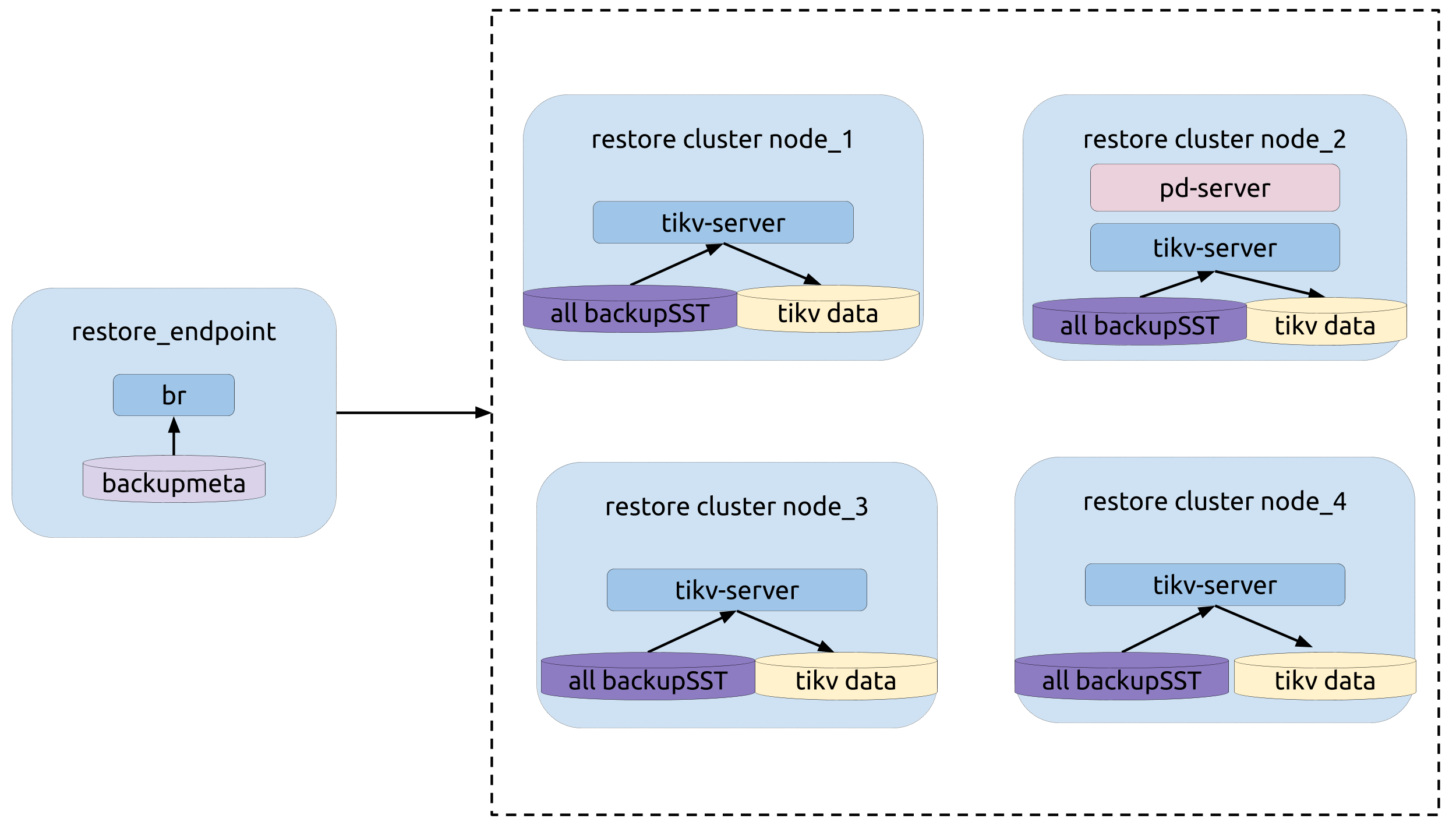
Restoration operation
Run the br restore command:
bin/br restore table --db batchmark --table order_line -s local:///home/tidb/backup_local/ --pd 172.16.5.198:2379 --log-file restore_local.log
During the restoration process, pay attention to the metrics on the monitoring panels to get the status of the restoration process. See Monitoring metrics for the restoration for details.
Restoration results explanation
In the log specified before running the restoration command, you can get the statistical information of the restoration operation from this log. Search "summary" in this log, you can see the following information:
["Table Restore summary:
total restore tables: 1,
total success: 1,
total failed: 0,
total take(s): 908.42,
total kv: 5659888624,
total size(MB): 353227.18,
avg speed(MB/s): 388.84"]
["restore files"=9263]
["restore ranges"=6888]
["split region"=58.7885518s]
["restore checksum"=6m19.349067937s]
The preceding log includes the following information:
total take(s): The restoration durationtotal size(MB): The data sizeavg speed(MB/s): The restoration throughputsplit region: The region split durationrestore checksum: The restoration checksum duration
From the preceding information, the following items can be calculated:
- The throughput of a single TiKV instance:
avg speed(MB/s)/tikv_count=97.2 - The average restoration speed of a single TiKV instance:
total size(MB)/(split time+restore time)/tikv_count=92.4
Error handling during backup
This section introduces the common errors that might occur during the backup process.
key locked Error in the backup log
Error message in the log: log - ["backup occur kv error"][error="{\"KvError\":{\"locked\":
If a key is locked during the backup process, BR tries to resolve the lock. A small number of this error do not affect the correctness of the backup.
Backup failure
Error message in the log: log - Error: msg:"Io(Custom { kind: AlreadyExists, error: \"[5_5359_42_123_default.sst] is already exists in /dir/backup_local/\" })"
If the backup operation fails and the preceding message occurs, perform one of the following operations and then start the backup operation again:
- Change the directory for the backup. For example, change
/dir/backup-2020-01-01/to/dir/backup_local/. - Delete the backup directory of all TiKV nodes and BR nodes.
- Audience
- Prerequisites
- Back up a single table to a network disk (recommended for production environments)
- Restore data from a network disk (recommended for production environments)
- Back up a single table to a local disk (recommended for testing environments)
- Restore data from a local disk (recommended for testing environments)
- Error handling during backup